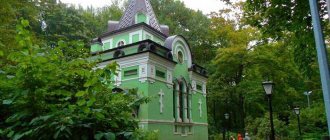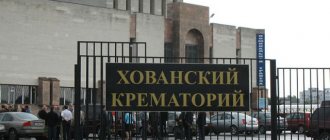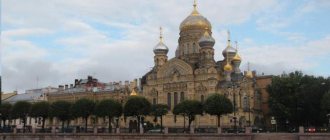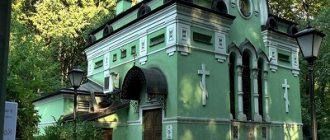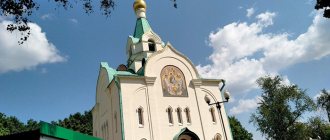Smolenskoye is one of the oldest cemeteries in St. Petersburg. It began its “work” in the middle of the 17th century and over time grew into a large cemetery with an area of more than 50 hectares. Previously, everyone was buried, regardless of class. Now famous people of cinema, art, and science have found their last refuge here. Not long ago, the graves of director A. Balabanov, actress A. Samokhina, and singer E. Khil appeared here. Employees of the Academies, the Mining Institute, and artists of the Mariinsky and Alexandrinsky theaters are buried at separate sites. Here you can find both traditional burials and columbariums - places designed for urns with ashes.
Also on the territory of the cemetery there is a chapel in memory of Xenia the Blessed - a place of constant pilgrimage for the suffering. And at the very entrance to the cemetery there is the Smolensk Church. Local attractions include the erected memorial plaque with the name of Arina Rodionovna, A. Pushkin’s nanny (although the exact location of her grave is unknown, but they say she is buried at the Smolensk cemetery) and the so-called “Blokovsky path”.
Here in 1921 there was the first grave of the poet A. Blok. Then, in 1944, it was moved to the Volkovskoye cemetery, but a memorial stone remained, to which fans of the poet’s work still bring flowers. The unusual monument, discovered in the pre-revolutionary years, arouses curiosity. It is dedicated to the ranks of the Russian police and is under the care of traffic police officers.
Directions to the Smolensk Cemetery
The cemetery is located near the Smolenka River, on Vasilyevsky Island. Getting there is not difficult at all.
From metro station "Vasileostrovskaya"
The closest metro station is Vasileostrovskaya. Let's start with it.
On foot
Have you decided to walk? Great!
- We left the metro, turned left from the exit and got onto the 8th line.
- Further along the line to the intersection with Kamskaya Street (the numbering of houses will increase, and you will come out on the embankment of the Smolenka River).
- Here you turn left again and walk along Kamskaya Street to the gates of the Smolensk Cemetery.
Depending on your speed, the journey from the metro to the cemetery will take from 20 to 45 minutes.
By minibus
If you don’t have time or you’re tired, you can get to the place by minibus.
There is a stop opposite the metro exit. Wait for the minibus number K-249, get in and drive to the Smolensk cemetery, to its main entrance. The entire trip takes no more than 15 minutes.
From the Primorskaya metro station
On foot
- Coming out of the metro, you need to turn left and go around the high-rise building where the Primorskaya station is located. This is Odoevsky Street. It stretches along the Smolenka River. You need to walk so that you have Cash Street and Cash Bridge behind you.
- Along the way you will come across a small bridge through which you will need to cross to the other side. Bering Street runs here.
- Straight ahead, after about 200 meters, a cemetery will appear. It looks very much like a park and you definitely won’t be able to pass by it.
By public transport
Having reached the final station "Primorskaya" and exiting the metro, you can choose a minibus with number K186 or bus number 42. The time spent on the trip will be no more than 5 minutes. You will come out to the northwestern entrance to the cemetery.
The territory occupied by the cemetery is surrounded by the 17th line of Vasilyevsky Island, Maly Prospekt, Bering Street and the Smolenka River. There are buildings here that have become national property. Such as: Smolensky, Trinity and Resurrection churches, Tent Iron, Wooden, Gate chapels, a chapel for the deceased with contagious diseases, chapel-burial vaults of Xenia of Petersburg and Anna Lozhkina (the holy fool).
Cemetery services offer to use their services: buy flowers, wreaths, decorations for graves. At the rental office you can get the necessary equipment for arranging a grave. In all churches and on the territory of the cemetery, you can leave notes to commemorate the dead.
Facts about the Smolensk cemetery. — How to get to the Smolensk cemetery in St. Petersburg?
Getting to the Smolensk Cemetery in St. Petersburg is easy. There are 2 metro stations on Vasilyevsky Island: Primorskaya and Vasileostrovskaya. The closest station to the Smolensk cemetery in St. Petersburg is the Vasileostrovskaya metro station. Let's start with it.
How to get to the Smolensk cemetery from the station. m. "Vasileostrovskaya"?
From the Vasileostrovskaya metro station you can walk or take a minibus. It all depends on your decision.
We decided to walk to the Smolensk cemetery from the station. m. "Vasileostrovskaya"?
To do this, upon exiting the lobby of the Vasileostrovskaya metro station, you need to turn left and go to the 8th line. Next you should walk along the line until it intersects with Kamskaya Street. The numbering of houses will increase. You will need to go to the embankment of the Smolenka River. Here again turn left and walk along Kamskaya Street to the gates of the Smolensk Cemetery. The journey from the metro to the cemetery can take from 20 to 45 minutes.
We decided to take a minibus to the Smolensk cemetery from the station. m. "Vasileostrovskaya"?
Instead of walking from the Vasileostrovskaya metro station, you can quickly and successfully get to the Smolensk cemetery by minibus. There is a stop opposite the exit from the Vasileostrovskaya metro station. Minibus K-249 is coming to the place. This transport will take you to the Smolensk cemetery, right to the main entrance. The entire trip takes no more than 15 minutes.
How to get to the Smolensk cemetery from the station. m. "Primorskaya"?
You can also get to the Primorskaya metro station either on foot or by minibus. Your decision and go ahead!
We decided to walk to the Smolensk cemetery from the station. m. "Primorskaya"?
On foot, leaving the Primorskaya metro station, you need to turn left and go around the Primorskaya station building itself. Here passes Odoevsky Street, which stretches along the Smolenka River. You need to walk in such a way that both Cash Street and Cash Bridge are behind you.
Along the way you will come across a small bridge through which you will need to cross to the other side. Bering Street runs here. You will see a place, after about 200 meters, very similar to a park and you will not be able to pass by it, since it will already be the Smolensk cemetery.
We decided to take public transport to the Smolensk cemetery from the station. m. "Primorskaya"?
Having reached the Primorskaya metro station, and the final one, leaving the lobby, you can take the K-186 minibus. Also, bus number 42 goes to the Smolensk cemetery. When choosing any transport, the time spent on the trip will be no more than 5 minutes.
You will find yourself at the northwestern entrance to the Smolensk cemetery. For reference: the territory occupied by the Smolensk Orthodox Cemetery in St. Petersburg is surrounded by the 17th line of Vasilyevsky Island, Maly Prospekt, Bering Street and the Smolenka River.
Address of the Smolensk Orthodox Cemetery
- St. Petersburg, Kamskaya street, 26
When is the Smolensk cemetery open in St. Petersburg?
- The Smolensk cemetery is open: in summer from 9:00 to 19:00, in winter from 9:00 to 17:00.
In conclusion, let us once again draw your attention to the fact that the Smolensk cemetery in St. Petersburg is the oldest in the entire city. As mentioned above, the cemetery appeared almost simultaneously with the city itself. Also, if you are interested in mysticism, then it is worth noting that the Smolensk cemetery is mysterious and endowed with mysticism with many legends.
- Bonus for you if you are very interested in learning about 6 mystical places in St. Petersburg to tickle your nerves and inject a decent dose of adrenaline into your blood.
Saint Petersburg
59° 56.3206 ′N, 30° 19.5213 ′E 59.93868N, 30.32536E 59°56′19.23″N, 30°19′31.28″E
- Map
- Notes 1317
- Photos 38,029
Links from experienced people
You can follow all new publications on any country or city using the feeds on your personal page, as well as using an RSS subscription. More details
- in My feeds
Use this code to insert a link to this destination into the text of a travel note, advice, blog post or forum post on Turbine. More details
This list includes authors who have received the highest ratings for materials about St. Petersburg.
Add the user as a friend if you want to follow his new materials, statuses and messages on the forums. If you just want to save the user’s data so as not to search for him again in the future, add him to your contacts .
How to get there. Smolensk cemetery.
Address: Kamskaya st., 3 Metro station: Primorskaya
The cemetery occupies the territory between the 17th line of Vasilyevsky Island, Maly Prospekt, Bering Street and the Smolenka River. The main entrance is from Kamskaya Street (in the northeastern part of the cemetery). But if you walk from the Primorskaya metro station, the northwestern entrance to the cemetery will be closer. Exit the metro, turn left and go around the high-rise building where the Primorskaya station is located. You will find yourself on Odoevsky Street, which runs along the Smolenka River. You should go in the opposite direction from Nalichnaya Street and Nalichny Bridge. Next you will see a small bridge, cross it, and you will find yourself on Bering Street. After 200 meters there will be a cemetery.
You can also get there from the Vasileostrovskaya metro station, but by minibus K-249. The minibus goes all the way to the entrance to the cemetery. This is the main entrance from Kamskaya Street.
Historical reference. 1756 - The Senate establishes the Smolensk cemetery. 1790 - completion of construction and consecration of the stone church in the name of the Smolensk Mother of God (architect A. A. Ivanov). 1902 - a chapel was erected over the grave of Xenia of St. Petersburg (architect A. A. Vseslavin). 1988 - the Chapel of Xenia the Blessed was restored and re-consecrated.
Do we book the hotel through Booking as always? In the world, not only Booking exists (for a huge percentage from hotels - we pay!) I have been practicing Rumguru for a long time, it is really more profitable than Booking.
Do you know Tripster? this is the evolution of city tours. The VIP guide is a city dweller, he will show you the most unusual places and tell you urban legends, I tried it, it’s fire! Prices from 600 rub. - they will definitely please you
The best search engine on the Runet, Yandex ❤, has started selling air tickets!
The mysticism of the Smolensk cemetery in St. Petersburg
St. Petersburg is a city famous not only for its architectural ensembles. He is widely known among fans of mystical phenomena. The northern capital has collected many secrets and mysteries; there are many terrifying legends about it.
One of the interesting mystical places is the oldest cemetery in St. Petersburg - Smolenskoye . Even walking along its paths during the day or just passing by, you feel an extraneous force, goosebumps run through your body. In fact, its name is associated with the construction of a church dedicated to the icon of the Smolensk Mother of God.
Why is the cemetery called Smolensky? According to legend, Vasilyevsky Island was built by residents of the city of Smolensk, who quickly died. The cause of death was harsh working conditions. The workers were buried on the southern bank of the Black River. This is where the cemetery got its name - Smolensk. But this has not been documented, so one can only guess at the veracity of this information.
The patron saint of the Smolensk cemetery is Ksenia the Blessed . There is a belief that after the death of her husband, she put on a man's overcoat, gave away all her wealth and began to wander around the city, telling various nonsense to people passing by. The unusual prophecies that she cast after passers-by came true. It turned out that Ksenia discovered the gift of clairvoyance.
Later, after the death of the mentally ill, people began to come to her grave and pray for help. Soon after her death, the chapel of Xenia the Blessed was rebuilt at the Smolensk cemetery. There is a belief that if you walk around the chapel three times, your wish will come true.
You might be interested in:
There are rumors that prisoners were buried on Vasilyevsky Island, although officially there was not a single approved cemetery in the Northern capital. They were buried wherever necessary. Convicts were buried in shackles. There are stories in which witnesses claim to have encountered the ghosts of imprisoned prisoners. Some heard the ringing of the chains of the dead.
But the most terrible myth is the story of 40 priests who died during the revolution . During the time the Reds seized power, faith in God was rejected. Forty clergy from all over St. Petersburg were collected and brought to the Smolensk cemetery, where they were offered to renounce their faith in exchange for life. Standing in front of a huge dug hole, all the servants of God chose death, after which they were buried alive. There are rumors that for three days after the murder, the ground on the grave was shaking, and the groans of the victims were heard at a distance of tens of meters. Some townspeople, having learned about this story, began to consider the Smolensk cemetery a desecrated place where evil spirits live.
It is believed that if you turn right at the entrance to the cemetery - into the old part - a person will certainly come face to face with a real ghost. People who love peace and quiet walk along the narrow paths on the left side of the cemetery. Sometimes during the day you can even find adults walking with babies along the ancient gravestones. And thrill-seekers come to the cemetery at night in search of the paranormal.
How to get to the Smolensk cemetery?
There are several entry points to the cemetery:
- Metro Vasileostrovskaya and then minibus K-249. Anywhere on foot for about 15 minutes through Maly Prospekt VO.
- Primorskaya metro station, no more than 10 minutes on foot, but the entrance to the cemetery will be on the other side of the Ksenia Chapel.
Who is buried at the Smolensk cemetery
At first, mostly people of ordinary rank and poor people were buried here. But over time, students and teachers of the university and the Academy of Arts began to settle on Vasilyevsky Island. Burials of artists, poets, scientists and sculptors began to appear in the cemetery.
Grave of 40 priest-martyrs at the Smolensk cemetery
Historical figures who were buried at the Smolensk cemetery:
- Arina Rodionovna, nanny of A. S. Pushkin (1828). Although her grave is unknown, there is a memorial plaque indicating the fact of her burial. Until 1940, it was believed that the grave was located at the Bolsheokhtinsky St. George Cemetery. However, bibliographer A.I. Ulyansky proved that in Smolensk;
- T. G. Shevchenko (1861). Two months later, his ashes were transported to Ukraine to the city of Kanev;
- A. Blok (1921), great Russian poet, reburied (1944) on the Literatorskie Mostki;
- A. G. Faberge (1895), artist-jeweler, brother of the famous Carl Faberge;
- Ludwig Nobel (1888), Swedish inventor, entrepreneur and public figure, brother of the famous Alfred Nobel, who established the Nobel Prize. He lived in Russia for many years, managed a machine-building plant here, created the best oil company;
- P.K. Kozlov (1935), traveler, researcher of Central Asia, including Mongolia and Tibet, student of N.M. Przhevalsky;
- B. S. Jacobi (1874), physicist, designed the first telegraph apparatus, electric motor;
- V. K. Trediakovsky (1769), Russian poet and scientist;
- A. F. Mozhaisky, inventor of the aircraft;
- many other scientists and artists.
The grave of the poet Alexander Blok
The cemetery often suffered from floods, weather conditions, and human neglect. Many burials and monuments were lost. Therefore, in order to preserve the most valuable of them, the authorities began to transfer them to other, more comfortable and protected cemeteries, to museums.
In 1931 and in subsequent years, many outstanding scientists, artists, actors, composers, writers and poets were reburied from the Smolensk cemetery.

